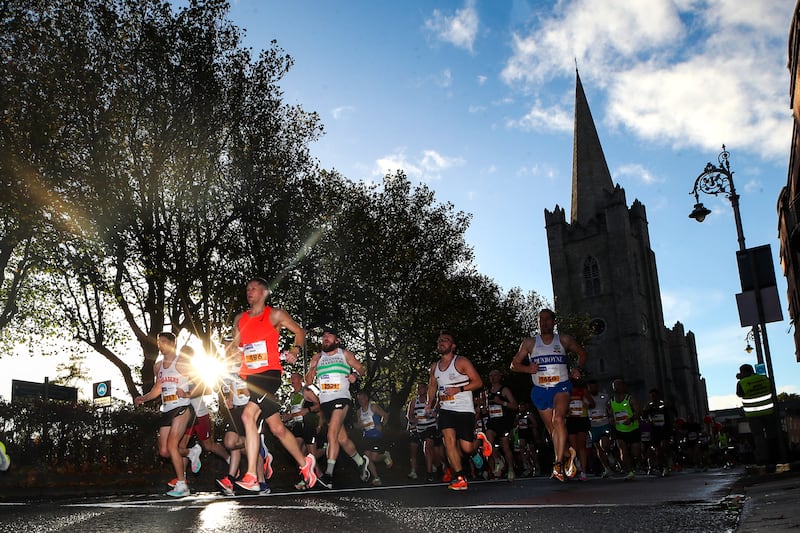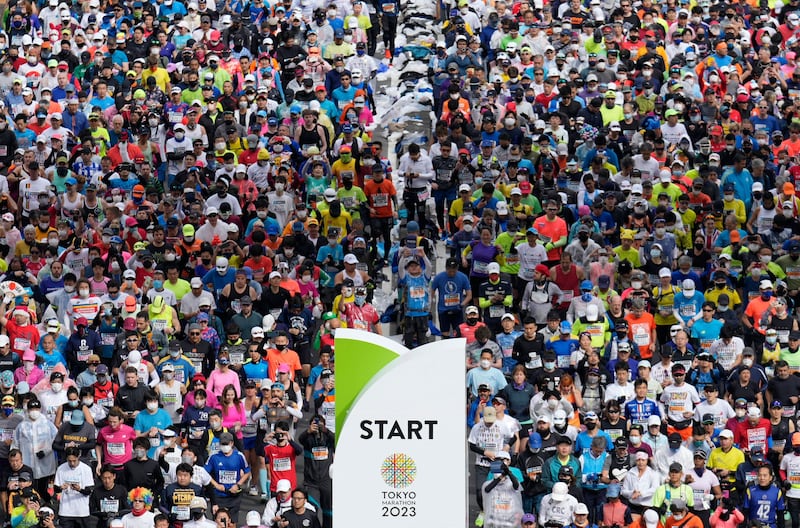Every marathon journey is about reaching your destination: the finish! Beginning here and continuing on the first Monday of each month, The Irish Times will run a series of lessons to help make that journey easier and smoother and a little more fun – all the way to the finish of the 2023 Dublin Marathon.
Sunday October 29th, Merrion Square, Dublin.
Congratulations. You made it. All done in good time, and hold on to that finisher’s medal. One less thing to do in life.
That’s not getting too far ahead already. Trust me, any successful marathon training programme begins at the finish, then works its way back from there. To somewhere around here, over six months out from the start.
It doesn’t matter if you’re running for the first time or (you think) the last time. Because of all the guarantees that come with finishing a marathon – terrible muscle soreness, vicious blistering, crippling dehydration – comes the realisation the real fun part of reaching that destination is in the journey itself.
With that comes the inevitable thought of running one better again. Or at least trying again, and failing better. For those who have never run a marathon there is always the wonder of “what if?” As if they can’t even imagine it. What do you mean you can’t? Of course you can.
The 2023 Dublin Marathon, the 42nd running of the event first staged in 1980, is once again a 25,000 sell-out, and for many of you the long journey to the October Bank Holiday weekend is about to get underway. It’s a similar journey for anyone considering another of the autumn marathons such as Berlin, Amsterdam, Chicago or New York.
Dublin has a lasting place in my marathon-running experience. It was my first and still my fastest: that was after five months of mostly made-up training which lured me into thinking I could be the best of the Irish. Which for a while I was, passing halfway in 70 minutes and still mixing it with the Kenyans, before both wheels blew off and I finished in 2:31.09, swearing never again.
Never swear never again: over the 20 years since, the lessons learnt from running other marathons near and far – on the streets of London and the back hills of Jamaica, through the rubble and ruins of Athens and along the coast Honolulu – have all been different and, in their own way, lasting too.
Marathon running may not be for everyone, but never has it been more accessible. Nowhere does the mass sporting participation event meet the ultimate endurance test with such lasting popularity.

No other sporting event also delights in the long countdown more than this classic distance. It doesn’t matter whether you’re training to win the thing or simply finish, it’s all about embracing these months to ensure the smoothest possible run on the day.
There is no such thing as a short cut either: whether it’s the 26 miles and 385 yards, or the 42.2km, the 138,336ft or 60,000-odd steps between the start and the finish, it’s the same distance for everyone.
Con Houlihan once described the marathon as the equivalent of conquering a horizontal Everest, and the comparison is justified: because as any proper mountaineer will tell you, no summit is successful without a successful descent.
Getting to the top is optional, getting down is mandatory, and if hitting 21 miles in the marathon feels somewhere near the summit, it’s still an awful long way down.
It’s always been hard to explain the marathon to anyone who has never run one. It’s also why when Noel Carroll helped start up the first Dublin Marathon, in 1980, he had to run it too, so that his marathon philosophy always came from experience.
“It’s not the distance that kills, it’s the pace,” he said, and that’s old advice which will always ring true. Carroll was never shy about sharing his philosophy: “I used to be an eccentric; now I’m an expert. I was once tolerated; now I’m consulted. I have graduated from somebody who should know better to somebody who knows better.”
There will be lessons for marathon runners of all different abilities: like learning to eat and drink on the run; some of my favourite marathon-enhancing substances (all perfectly legal, naturally); and how to deal with the most terrifying marathon prospect of all, The Wall.
The journey begins again.
Do
Consider joining a running club; if you’re not a running member already. Marathon running is often portrayed as a lonely exercise when the opposite is true, the journey best shared and sure to pass easier too.
Martin Kelly was just 18 when he ran and finished the first Dublin Marathon in 1980, when almost a third of the 2,100 starters in 1980 failed to finish the race. He’s been back and finished every year since, one of only a handful of runners to achieve that feat, and he puts his longevity down to joining Raheny Shamrocks, in 2002, who always have a group of members training for Dublin across all levels of expectation.
Running in a group will also help ensure you don’t peak too, or worse still over-train. There will be setbacks and inevitable obstacles (injury, illness or some unavoidable absence) but every long run is money in the marathon bank. It will be there to call on come marathon Sunday.
Don’t
Worry so much about getting the air in. Running we all know leaves you breathless. The harder you run, the more out of breath you become. Running well is all about good breath control – getting it in, getting the best out of it, and getting it out again.
There’s lots of different advice around breathing these days, some old school, some of the nasal-breathing school, some of the Wim Hof school.
Getting it in is straightforward enough. Smoothly and certainly not gulping, mouth wide open, makes sense. How well we use the breath when we get it in depends of course on the efficiency of our body, and more specifically on our heart and lungs.
Getting the air out efficiently, exhaling, is worth working on. A lot of runners exhale too fast. So try to control the output of breath. A relaxed and natural breath in, that should take care of itself. Then think about pushing it out a bit more. It will make you a more relaxed and efficient runner, and with time, a faster marathon runner.

Targets
Sunday’s Tokyo Marathon marked the beginning of the spring marathon season. London, Paris, Rome and Boston come in the weeks ahead and may already be a target for some, only not for the journey that begins here.
At this point, before any talk of running distances or indeed races, the most important thing is to be running smoothly. Does that Achilles tendon cry at you in the morning? Anything wonky going on around the knees when walking up or down the stairs? Is that some dull ache or pain in or around the groin area?
Now is the time to iron out any of these issues. Some may require consultation with a trained physio. That’s your call.
Either way now is the time to afford yourself 10 minutes worth of gentle stretching before and preferably again after each run, no matter how long or short. Think about investing in a foam roller, if you haven’t already: they are a handy way of loosening up the leg muscles and especially when rolling out of bed in the morning.






















